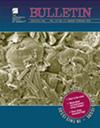U-Th-Pb dating, trace elements, and Sr-Nd isotopes of monazite and allanite as recorders for multi-stage rare earth element mineralization and remobilization in carbonatite dike systems
IF 3.7
1区 地球科学
Q1 GEOSCIENCES, MULTIDISCIPLINARY
引用次数: 0
Abstract
Carbonatite hosts the most important rare earth resources in the world, but the precise timing, ore-forming history, and mechanism of rare earth mineralization in carbonatite systems are still in debate. Here, we report a rare corona texture of monazite-allanite-fluorapatite from the Huangjiagou carbonatite in the Lesser Qinling of central China, and demonstrate that the U-Th-Pb dating, trace elements, and Sr-Nd isotopes of these minerals in the corona are useful tools to unravel multiple-stage events for rare earth element (REE) mineralization and mobilization. The first mineralization event took place at ca. 219 Ma as revealed by the monazite U-Pb age, the same as regional carbonatite forming ages, but the Th-Pb age has been disturbed, which shows a negative correlation with Th contents. The second mineralization event occurred at ca. 128 Ma, as revealed by in situ U-Pb dating of allanite, coeval with the intrusions of neighboring I-type granite. The initial Sr-Nd isotope ratios of allanite show a downtrend from the center to the rim of monazite-allanite-apatite coronas to approach the ratios of neighboring granite, indicating an increasing effect by the metasomatism of magmatic-hydrothermal fluids during the growth of these REE-mineral coronas. Therefore, a two-episode REE mineralization was recognized with the replacement of ca. 219 Ma monazite by ca. 128 Ma allanite-apatite coronas on the function of magmatic-hydrothermal fluid metasomatism, and this process accompanies the disturbance of Th/Pb geochronology in monazite. Allanite as the product of monazite dissolution can represent the later-stage REE mineralization tracing the REE reworking processes under the hydrothermal conditions in carbonatite systems. Our study highlights the implication of monazite-allanite-fluorapatite coronas on the REE remobilization and mineralization in carbonatite systems.独居石和绿帘石的铀-钍-铅年代测定、微量元素和锶-钕同位素作为碳酸盐岩堤系统中多级稀土元素成矿和再移动的记录器
碳酸盐岩蕴藏着世界上最重要的稀土资源,但碳酸盐岩系统中稀土成矿的精确时间、成矿历史和机制仍存在争议。在此,我们报告了中国中部小秦岭黄家沟碳酸盐岩中罕见的独居石-安澜石-氟磷灰石的电晕纹理,并证明电晕中这些矿物的U-Th-Pb年代测定、微量元素和Sr-Nd同位素是揭示稀土元素成矿和移动的多阶段事件的有用工具。独居石U-Pb年龄显示,第一次成矿事件发生在约219 Ma,与区域碳酸盐岩形成年龄相同,但Th-Pb年龄受到干扰,与Th含量呈负相关。第二次成矿事件发生在约 128 Ma。奥氏体的原位 U-Pb 定年显示,第二次成矿事件发生在约 128 Ma,与邻近 I 型花岗岩的侵入同时发生。绿帘石的初始Sr-Nd同位素比值从独居石-绿帘石-磷灰石冠岩的中心到边缘呈下降趋势,接近邻近花岗岩的比值,表明在这些REE-矿物冠岩的生长过程中,岩浆-热液的变质作用在不断增强。因此,在岩浆-热液变质作用下,约219 Ma的独居石被约128 Ma的绿帘石-磷灰石冠岩所取代,从而形成了两期REE成矿作用,而这一过程伴随着独居石中Th/Pb地质年代的扰动。钠长石作为独居石溶解的产物,可以代表碳酸盐岩系统热液条件下后期的REE成矿过程。我们的研究强调了独居石-闪长岩-氟磷灰石冠状体对碳酸盐岩系统中REE再移动和矿化的影响。
本文章由计算机程序翻译,如有差异,请以英文原文为准。
求助全文
约1分钟内获得全文
求助全文
来源期刊

Geological Society of America Bulletin
地学-地球科学综合
CiteScore
9.30
自引率
8.20%
发文量
159
审稿时长
4-8 weeks
期刊介绍:
The GSA Bulletin is the Society''s premier scholarly journal, published continuously since 1890. Its first editor was William John (WJ) McGee, who was responsible for establishing much of its original style and format. Fully refereed, each bimonthly issue includes 16-20 papers focusing on the most definitive, timely, and classic-style research in all earth-science disciplines. The Bulletin welcomes most contributions that are data-rich, mature studies of broad interest (i.e., of interest to more than one sub-discipline of earth science) and of lasting, archival quality. These include (but are not limited to) studies related to tectonics, structural geology, geochemistry, geophysics, hydrogeology, marine geology, paleoclimatology, planetary geology, quaternary geology/geomorphology, sedimentary geology, stratigraphy, and volcanology. The journal is committed to further developing both the scope of its content and its international profile so that it publishes the most current earth science research that will be of wide interest to geoscientists.
 求助内容:
求助内容: 应助结果提醒方式:
应助结果提醒方式:


